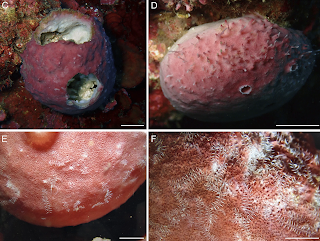 |
| Ramisyllis kingghidorahi Aguado, Ponz-Segrelles, Glasby, Ribeiro, Jimi & Miura, in Aguado, Ponz-Segrelles, Glasby, ... et Miura, 2022. |
Abstract
Among over 20,000 species of Annelida, only two branching species with a highly modified body-pattern are known until now: the Syllidae Syllis ramosa McIntosh, 1879, and Ramisyllis multicaudata Glasby et al. (Zoological Journal of the Linnean Society, 164, 481–497, 2012). Both have unusual ramified bodies with one head and multiple branches and live inside the canals of host sponges. Using an integrative approach (combining morphology, internal anatomy, ecology, phylogeny, genetic divergence, and the complete mitochondrial genome), we describe a new branching species from Japan, Ramisyllis kingghidorahi n. sp., inhabiting an undescribed species of Petrosia (Porifera: Demospongiae) from shallow waters. We compare the new species with its closest relative, R. multicaudata; emend the diagnosis of Ramisyllis; and discuss previous reports of S. ramosa. This study suggests a much higher diversity of branching syllids than currently known. Finally, we discuss possible explanations for the feeding behaviour in the new species in relation to its highly ciliated wall of the digestive tubes (especially at the distal branches and anus), and provide a hypothesis for the evolution of branching body patterns as the result of an adaptation to the host sponge labyrinthic canal system.
Keywords: Mitochondrial genome, Phylogenetics, Sponge, Syllidae, Symbiosis, Morphology, Anatomy, Ecology
Taxonomy
Ramisyllis Glasby et al., 2012
Diagnosis (after Glasby et al. (2012), emendations in bold).
“Ribbon clade” Syllinae, with non-flattened body, more or less cylindrical segments and a multiaxial, dendriform pattern; first branch occurring after segments 14–24. Branches emerging after parapodia (not replacing them or dorsal cirri) and showing same segment size and cirri length as previous branches. Three antennae; palps free to base; two pairs of tentacular cirri; pharynx slender, mid-dorsal tooth absent in adults; dorsal cirri articulated, with alternating thick/slender pattern on mid-body and posterior segments; ventral cirri present, not articulated, inserted proximally; single type of simple chaeta present, tomahawk-shaped. Sexes separate. Reproduction by schizogamy, gemmiparitity. Acerous, dimorphic stolons. Commensal inside shallow water species of Petrosia. Mitochondrial gene order strongly modified. Nuclear ribosomal sequences highly derived compared to other Syllinae.
Ramisyllis kingghidorahi n. sp. Aguado, Ponz-Segrelles, Glasby, Ribeiro, Jimi & Miura
Diagnosis: Species of Ramisyllis, sister-group related to R. multicaudata, long anterior tentacular and dorsal cirri (twice long as midbody ones), long proventricle (through 4 segments), stolon stalks similar to other segments in regular branches and proliferation of new branches in intersegmental areas.
Etymology: The name refers to King Ghidorah, the three-headed and two-tailed monster enemy of Godzilla. Both characters were created by Tomoyuki Tanaka based on Japanese mythology and folklore. King Ghidorah is a branching fictitious animal that can regenerate its lost ends. King Ghidorah is assumed to be a male and latinized accordingly.
Distribution and habitat: Coastal waters of Sado Island, Japan, around 15 m deep; symbiont of Petrosia sp. (pink form).
M. Teresa Aguado, Guillermo Ponz-Segrelles, Christopher J. Glasby, Rannyele P. Ribeiro, Mayuko Nakamura, Kohei Oguchi, Akihito Omori, Hisanori Kohtsuka, Christian Fisher, Yuji Ise, Naoto Jimi and Toru Miura. 2022. Ramisyllis kingghidorahi n. sp., A New Branching Annelid from Japan.
Organisms Diversity & Evolution. DOI: 10.1007/s13127-021-00538-4






